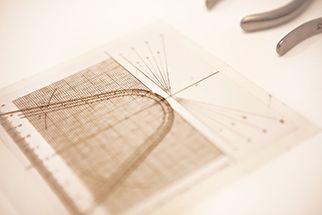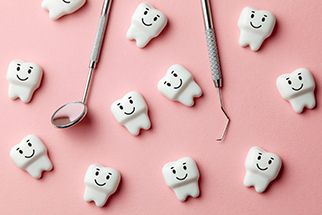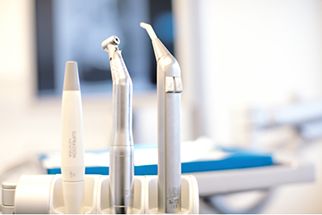
Von Zahn- und Kieferfehlstellungen sind viele Kinder und Jugendliche betroffen. Aber auch im Erwachsenenalter können Korrekturen nötig werden, z.B. nach Zahn- oder Knochenverlust.
Es ist die Aufgabe des Fachzahnarztes für Kieferorthopädie durch geeignete Verfahren, eine gut funktionierende und ästhetisch ansprechende Zahnstellung herzustellen, die bei richtiger Pflege zeitlebens erhalten werden kann.
Weitere Infos:Schweizerische Gesellschaft für Kieferorthopädie
Problematische Zahn- und Kieferstellungen treten häufig kombiniert auf. Eine sorgfältige Diagnose und Behandlungsplanung sind somit äusserst wichtig.
Zuerst klärt der Kieferorthopäde ab, ob die Ursache der Fehlstellung auf einer falschen Lage oder Entwicklung der Kiefer beruht (sog. skelettale Abweichung) und ob eine Fehlstellung der Zähne vorliegt (sog. dentale Abweichung).
Entsprechend den therapeutischen Aufgaben kommen bei einem Patienten verschiedene Apparaturen zum Einsatz: Oft wird in einer ersten Phase das Kieferwachstum beeinflusst. In einer zweiten Phase (nach Abschluss des Zahnwechsels) wird schliesslich die Fehlstellung der einzelnen Zähne korrigiert.
Zu beachten gilt, dass bei allen Korrekturen eine zuverlässige Mitarbeit des Patienten und eine gute Mundhygiene erforderlich sind, damit das Behandlungsziel erreicht werden kann.
Die Oberkieferzähne stehen deutlich vor der unteren Zahnreihe (häufigste Kieferabweichung).
Hier liegen die unteren Frontzähne vor dem oberen Zahnbogen.
Der Oberkiefer ist im Verhältnis zum unteren Zahnbogen zu schmal.
Aufgrund einer fehlenden Abstützung beissen hier die unteren Frontzähne auf die obere Gaumenschleimhaut. Dadurch kann das Zahnbett der oberen Zähne nachhaltig geschädigt werden.
Die Zähne beissen (meist vorne) nicht aufeinander. Bei jungen Patienten ist häufig Nuggi- oder Fingerlutschen die Ursache dafür. Der offene Biss beeinträchtigt die Beissfunktion und die Sprache bzw. Lautbildung.
Bei einem Missverhältnis zwischen Zahn- und Kiefergrössen oder bei vorzeitigem Milchzahnverlust entstehen sog. Engstände, welche die Zahnreinigung zwischen den Zähnen erschweren. Dies begünstigt Karies und Zahnfleischentzündungen, was im Erwachsenenalter zu einer Zahnbetterkrankung (Parodontitis) führen kann.

Man darf den richtigen Zeitpunkt einer kieferorthopädischen Behandlung im Laufe der Gebissentwicklung und des Kieferwachstums nicht verpassen. Bei zu frühem Beginn besteht sogar die Gefahr, dass die Behandlung zu lange dauert.
Massgebend für den Behandlungsbeginn beim Kind ist übrigens nicht das Alter in Lebensjahren, sondern das skelettale Alter und der zeitliche Ablauf des Zahnwechsels.
Quelle: Zahnärztegesellschaft SSO


Ich mag Kinder und Jugendliche enorm gerne und liebe es, mit ihnen zu arbeiten und ihr Vertrauen zu gewinnen. Als ehemalige Lehrerin und Zahnärztin an der Schulzahnklinik Zürich durfte ich im Umgang mit Kindern und Jugendlichen viele Erfahrungen sammeln. Diese helfen mir auch heute noch, erfolgreiche Zahnbehandlungen durchzuführen. Mit viel Respekt und Geduld, positiven Rückmeldungen und durch Erklären-Zeigen-Machen versuche ich, eine entspannte Situation zu schaffen, um das Ziel zu erreichen.
Es ist schön, Kinder unter optimalen Bedingungen behandeln zu können. So steht etwa ein Fernseher an der Decke des Behandlungszimmers zur Verfügung, auf dem Kinderfilme abgespielt werden können. Bei sehr ängstlichen oder kleinen Patienten kann ich – je nach Bedarf – die Entspannung mit Hilfe von Lachgas fördern.
Speziell am Herzen liegen mir auch die grösseren Kinder und Jugendlichen. Denn je älter, desto entscheidender wird die Eigenverantwortung gegenüber der Mundgesundheit. Als Zahnärztin möchte ich diese natürlich unterstützen und fördern, indem ich die Jugendlichen aufkläre und motiviere.
Ja, wenn es sich um Milchzahnlöcher auf der Seite handelt. Denn diese Löcher können ungeflickt zu Schmerzen oder gar Abszessen führen. Ausserdem ist es wichtig, die Platzverhältnisse für die kommenden, bleibenden Zähne zu sichern. Denn dieser Wechsel beginnt erst relativ spät: bei Mädchen im Durchschnitt erst kurz vor 10 Jahren, bei Buben erst mit ca. 10.5 Jahren und dauert bis zu 1.5 Jahre.
Sind die Löcher hingegen an den Milchschneidezähnen, empfehlen wir kein Reparieren, denn hier ist der Wechsel zu den bleibenden Zähnen bereits zwischen 6 – 8 Jahren. Falls diese Löcher jedoch schmerzen, werden die Milchschneidezähne gezogen.
Elektrische Zahnbürsten haben einen sehr guten Putzeffekt – wenn sie richtig angewendet werden. Wir empfehlen jedoch mindestens 1 x täglich noch von Hand zu putzen, damit die Putztechnik von Hand trainiert und verbessert werden kann. Achten Sie beim Kauf einer elektrischen Zahnbürste darauf, dass es eine Schallzahnbürste ist. Ausserdem soll der Bürstenkopf nicht zu gross und der Bürstengriff leicht und handlich sein. Gerne überreichen wir Ihnen eine Putzanleitung fürs Zähneputzen mit der Schallzahnbürste bei Ihrem nächsten Besuch.
Versuchen Sie, Ihr Kind zuversichtlich zu stimmen und lassen Sie es wissen, dass Sie uns vertrauen. Teilen Sie ihm mit, dass es alle Fragen stellen kann und ihm in Ruhe alles erklärt wird. Seien Sie mitfühlend, falls Ihr Kind am liebsten zu Hause bleiben möchte – es braucht Mut, sich auf etwas Unbekanntes einzulassen. Zeigen Sie dem Kind, dass Sie dies zusammen schaffen werden. Wer weiss, vielleicht hilft die Aussicht, dass durch die Behandlung kranke Zähne «gesund gemacht» werden, um sich ein bisschen auf das Ziel zu freuen.
Wir sind in der komfortablen Lage, dass in unserer Praxis Kieferorthopädie und Kinderzahnmedizin unter einem Dach zu finden sind. So ist es möglich, während der jährlichen zahnmedizinischen Kontrolle, die Sachverständigen Dr. Lorenzo Pagliaro und Dr. Isabella Scherer jederzeit beizuziehen. So kann der richtige Zeitpunkt für einen kieferorthopädischen Start festgelegt werden – nicht zu früh und nicht zu spät.

Unsere Praxis bietet Ihnen ein vernünftiges Preis–Leistungsverhältnis. Abgerechnet wird nach dem Tarif der Schweizerischen Zahnärztegesellschaft SSO (Dentotar).
Die Rechnungen werden transparent unter Auflistung aller verrechneter Positionen ausgestellt.
Vor der Behandlung werden Sie über die zu erwartenden Kosten umfassend informiert. Auf Wunsch erhalten Sie auch eine detaillierte schriftliche Kostenschätzung.
Es geltenden folgende Taxpunktwerte:
Privatpatienten: CHF 1.20
Kieferorthopädie: CHF 1.00
Unfallversicherungen und Sozialdienste: CHF 1.00